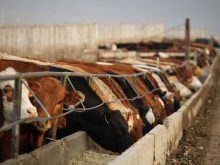A two-week-old strike at Canada’s largest beef processor hasn’t disrupted cattle markets at home or offshore.
Slaughter cattle have been shipped to other plants like Lakeside-IBP at Brooks, Alta., XL Foods in Calgary or the United States.
Among feeders, bids have been competitive from other buyers besides Cargill.
Jim Graham, a partner in the family-operated South Slope Feeders at Rainier, Alta., said some strong bidders from other markets have appeared.
“The redirection of the product for slaughtering and processing is taking place and it seems to be going very smoothly,” said Graham.
Read Also

Canadian-bred cow wins World Dairy Expo Holstein show
A cow bred in Saskatchewan, Lovhill Sidekick Kandy Cane, is the Grand Champion Holstein at the 2025 World Dairy Expo.
As chair of the Canada Beef Export Federation, Graham said export markets are not in jeopardy because beef supplies are plentiful.
“Are we going to lose sales? I think not,” he said.
Brenda Schoepp, market analyst and editor of Beeflink, said it’s hard to predict what could happen if the strike lingers over the summer.
What is saving Canadian cattle industry players is that last week’s cash markets in the U.S. improved over the week before.
“If U.S. cash would have stayed really sour we would probably be in trouble now,” said Schoepp.
Cash fed cattle prices improved last week with fed cattle closing at $1-$2 per hundredweight higher.
People shipping to the U.S. must watch the Canadian dollar. If it strengthens, they could lose money on the exchange rate.
The cash to cash price spread between Canada and the U.S. markets has historically been $8 and in the last month has tightened to about $5.50. This spread includes freight costs, cost of grading and exchange rates, said Herb Locke, market analyst with Farmsense Marketing in Edmonton.
He said the effect on the markets may not be noticeable on slaughter steers and heifers because they can go to other plants.
Can’t cover production
However, plants like Lakeside, XL Foods or Western Canadian Beef Packers in Moose Jaw, Sask. can’t pick up the entire kill.
“The meat will move down to the U.S. on the hoof and move back across in trucks,” said Locke.
“At this time of year the cattle in Alberta are closer to U.S. specs than they are any other time of the year. They are in hands that are fully capable of moving to export position should the local market falter at all.
“We’re not into farmer feeders who get spooked by a market,” he said.
Locke and Graham said there is industry concern that the United Food and Commercial Workers union is trying to give this strike a high profile, which the union then hopes will spread to other meat plants.
“This is not necessarily aimed at Cargill. It’s aimed at the industry. If you can break one down then the rest will have to follow,” Graham said.















